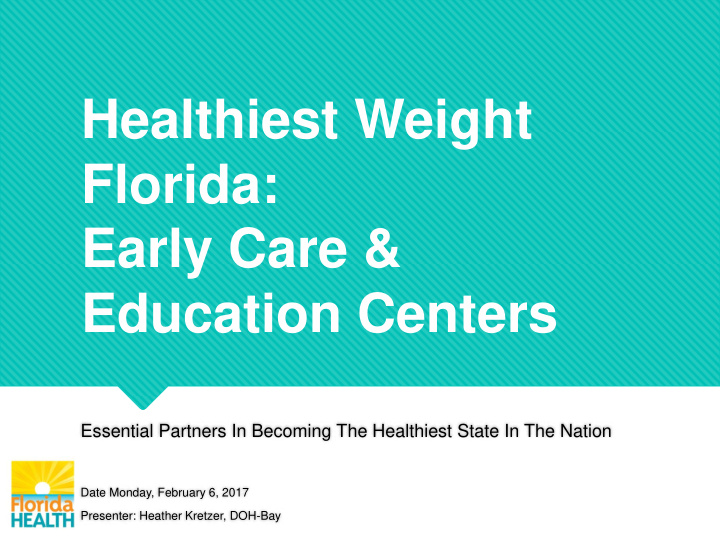



Healthiest Weight Florida: Early Care & Education Centers Essential Partners In Becoming The Healthiest State In The Nation Date Monday, February 6, 2017 Presenter: Heather Kretzer, DOH-Bay
Healthiest Weight Florida Healthiest Weight Florida (HWF) is a public-private collaboration bringing together state agencies, not for profit organizations, businesses, and entire communities to help Florida's children and adults make choices about healthy eating and active living.
Strategies 1. Integrate physical activity every day in every way 2. Make healthy food available everywhere 3. Strengthen schools as the heart of health 4. Empower employers to provide healthy worksites 5. Market what matters for a healthy life
Collective Impact Birthing Facilities Early Care & Communities Education Centers 6 Healthy Places Health Care Schools Settings Worksites
Adding Value ECEs are Valuable to Health Healthy habits that start during the preschool years can last a lifetime Most young children spend time in early care and education (ECE) centers, family child care settings or in preschool Providers have a unique opportunity to help children develop a foundation of healthy habits for life Health is Valuable to ECEs Health behaviors are associated with academic achievement Healthy students and school staff have better attendance
Adding Value Currently, in the US 41% of children aged 0-5 and 64% of children aged 3-5 yeas cared for each week in non-parental care arrangements, such as childcare centers, family childcare homes, pre-kindergarten classrooms, etc. Despite declines in obesity among young children, about 1 in 4 children aged 2-5 are overweight or have obesity Children who are overweight when they enter kindergarten are 4× more likely to have obesity in 8th grade compared to their peers who are at a normal weight Sources: https://www.cdc.gov/obesity/downloads/early-care-education-report.pdf
Adding Value In 2011 Nearly all children (97%) in Florida ages 1 to 5 watched TV or played video games daily 1 out of 9 watched TV or played video games four or more hours daily More than 1 out of 8 low-income children ages 2 to 4 were obese in Florida Sources: National Survey of Children’s Health, 2011/12 Pediatric Nutrition Surveillance System, 2008 – 2011
ECE Goal Increase the number of Early Care and Education Centers implementing best practices related to physical activity and nutrition. Two Best Practices Models: Let’s Move! Child Care 5-2-1-0
Best Practices Let’s Move! Child Care Best practices established in partnership with Nemours Children’s Health System and supported by the Centers for Disease Control and Prevention (CDC) Intended for all types of programs including family child care homes, Head Start programs, preschools and faith based programs
Best Practices Nurture Healthy Eaters Family Style-dining Make nutrition fun and engaging Serve a fruit and/or vegetable at every meal Limit fried foods
Best Practices Provide Healthy Beverages Water and milk are the best choices Have water visible and available both inside and outside for self-serve Serve whole milk only to children between one and two years old At two years old, serve only low fat (1%) or reduced fat (2%) milk Limit juice and NO sugary drinks
Best Practices Get Kids Moving Babies : tummy time 2-3 times per day Toddlers : 60+ minutes of active play time every day Preschoolers :120+ minutes of active play time every day
Best Practices Reduce Screen Time Limiting screen time is key for healthy development and staying active Screen time should be limited to no more than 30 minutes a week while in child care NO screen time for children under age two
Best Practices Support Breastfeeding Provide breastfeeding mothers access to a designated area, other than a bathroom, for breastfeeding or pumping with appropriate seating and privacy
Recognition Let’s Move! Child Care Overview Recognized providers meet best practices in five healthy goal areas Qualifying centers receive a certificate of completion and recognition on the national map Rolling recognition opportunity
Recognition Let’s Move! Child Care Where to Begin Sign up for Lets Move! Child Care Take the online quiz Make an action plan Monitor your progress Get on the map
LMCC Recognition Map Retrieved 09/13/2016*
Other Best Practices Model 18
A diet rich in fruits and vegetables provide vitamins and minerals, important for supporting growth and development, and for optimal immune function in children. Kids are more likely to eat fruits and vegetables when you present them in fun, creative ways. Limit unhealthy choices for snacks and celebrations. 19
Young children who spend less time watching TV tend to do better in school, have a healthier diet, and are more physically active when they are older. Too much screen time puts kids at risk for lower reading scores, attention problems, and problems learning. Prohibit screen time for children under the age of 2. For children 2 and older, aim to use screen time for educational purposes only. 20
Active kids tend to be healthier kids, and healthier kids are better learners Regular physical activity reduces feelings of anxiety, stress, and depression, and increases self-esteem. Physical activity has immediate and long-term benefits for everyone, both young and old. 21
Do not provide sugary drinks Serve 100% fruit juice to no more than one 4-6 oz. serving per day or do not serve at all. Water provides a low-cost, zero-calorie beverage options and is a healthy alternative to sugary drinks. 22
Summary Be a Healthy ECE Leader! 1. Adopt nutrition and physical activity best practices 2. Help your center achieve recognition!
Recommend
More recommend